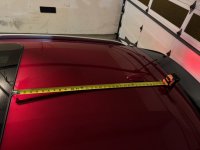Pretty clearly my limiter is going to be available roof space.
Roof is about 38" wide from side rail to side rail, but length measured from the back edge of the moonroof to the joint with the hatch assembly gives me only 33". Further, when the moonroof operates, it retracts about 13 1/2" into the headliner, so unless the underside of the NMO mount is incredibly low profile, it's likely to interact if it comes within that distance of the opening.
You're over thinking it. It's not going to be a 'perfect' groundplane. The moonroof compromises it. Drop the head liner a d put something on the roof to show you where the back side of moon roof sits when it's fully opened. Measure for the centre of the roof for a single mount, for dual NMO mounts divide it into thirds and mark between the first and second third, and between the second and third, third. Drill your holes.
KISS principle.
Trying to measure out for the centre of the tin behind the moonroof amd trying to route the coax so it doesn't interfere with the moonroof and its mechanism is going to be a pain in the ass. It's not going to gain you any noticeable performance.
Unless you can be 110% confident the underside of the mount AND coax won't interfere, rub or otherwise interfere with the roof opening and closing, keep them out of the travel path.
Yes the pattern will be skewed by the lack of uniformity of the groundplane, BUT you won't notice unless you are receiving really weak signals, and at that point its not going to be enjoyable to listen to and try and pick voices out of the static.
Even with the skewed pattern this way, it's going to perform a hell of a lot better than using a fender L-bracket, using a hammy gutter mount or a hammy lip mount.
I ran a 25w XPR5550 VHF, with a EMWave wideband 1/4(compromise antenna that gave acceptable SWR across most of the VHF spectrum) on my Jetta that had a moon roof for years. It was mounted in the hole thay would have been for the Sirrius/XM/GPS antenna if my car had the factory nav unit rather than the low end stereo. I had like 8 or 10" from the antenna to the rear of the roof. I didn't notice any nulls or skewed pattern. If I ever have a car with moon roof again, it will be a similar location. Behind the open moonroof offset towards the back so it won't interfere with the operation of the moonroof. If it's a VHF radio, it will be the same EMWave wideband 1/4, if it's a UHF radio, it will be an EMWave 1/4. If it's dual band, it will be a Larsen NMO-2/70B.
The only other suggestions I could make, are to program a button to change power levels. If I was using a 45w NX5xxx, I would program all my channels for medium power ~25w. I rarely felt I needed more than 25w, even traveling in the mountains. Not sure if I was just lucky, but I found 25w was balanced in almost all cases, if I could hear the repeater I could work it.
I used a NX700(similar chassis size) for years at an old job. At high power it WILL get hot in short order if your in a long conversation and regularly hitting the time out timer.
Speaking of which, enable the time out timer. 120 seconds is 2 minutes. No more than 180 seconds. No need to be super long winded. It will force you to turn it over, and if for some reason you stuff the mic in a seat or cup holder, it WILL save your finals.
Good luck on your project. I can't wait to see the final results. I'm glad you are not afraid of drilled NMO mounts.
Magnet/gutter and lip mounts are ugly and scream lazy. Drilling won't decrease value, and done properly absolutely won't leak, IF you install the mount AND the antenna gaskets properly.



